Burning Issues
LURE OF THE WILD
-Shivani Thakkur
Tiger killings happening rampantly all over our country is a source of concern for every one. The Tiger Task force set up to stop these killings as well design a programme
for future is being worked on. But the big question is not their depleting numbers; instead, WHY? Why is that tigers are mercilessly shot. Why kill a tiger? Is it for meat? Is it for their skin?
There was a time in pre-independence era that the tigers were killed to show off hunting skills or put up their skins as trophies. But that is history, now they are hunted for pure commercial
reasons. A tiger killed in India fetches Rs 5000 but in international market it retails at $50,000. It is shocking but true. The various body parts of tiger command a heavy price. And all these are used in the traditional Chinese medicines. From whiskers to
tail every part is saleable. Belinda Wright, director of Wildlife Protection Society of India says, “China is the manufacturing hub for medicines made from tiger derivatives. From China, these medicines are sent to various countries like US, UK and Japan mainly
to Chinese communities there.

A tiger tail, at Rs 9,200 apiece, is mixed with soap and sold as cure for skin disease. A bowl of penis soup for Rs1600 is used in love potions as an aphrodisiac. Thinges
like gall stones are used to cure abscesses and weak eyesight. Bile is used to treat convulsions in children. Bones at Rs 30,000 and above the most valued of the lot is powdered and prepared as tiger wine to soothe rheumatic pain, cure ulcers. Testes are used
to treat nymph node TB. Skin for Rs 45,000 is used in Tibet as high street fashion or to treat mental illness. Hair is burnt to drive centipedes. Brain to cure acne and laziness. Eyes (Rs 5500 a pair) treated for epilepsy, malaria, and cataract. Whiskers
used as good luck charm. Blood Rs 400 for 40cc bottle to strengthen and boost will power.
Whether these things are effective in curing or not is still an unknown fact. Likewise with other animals most of them are killed for their body parts. Otters,
who fall under Indian Wildlife Protection Act of 1972, are killed for their pelt used in traditional Tibetan costume. Mongoose hair is used in making hairbrushes for painting. Owls are trapped for their claws to drive away fear and nightmares in young children. Many
animals like snakes, crocodiles, hammerhead sharks, monitor lizard sea horses are supplied to schools to identify during exams.
Mr. M.K.Sharma, a special secretary in the Union Environment and Forest Ministry put up an idea of setting private breeders to breed wild animals for medicinal
products. But this idea drew harsh criticism as people questioned the foolproof sustenance of this. What guarantee would be there that a breeder would not surreptitiously smuggle animals from wild to increase the numbers and what would ensure that a breeder
wont be tempted to sell animals to recover his costs as cost of upkeep is pretty high.
All these facts point out the dismal condition of animals in our country. They are at peril as long as we overlook those sects of people who would much rather
take a magic potion to cure their ills rather than approach diseases scientifically and holistically. Yet there is little being done to stop all those people who want to make money fast by hook and crook.
( Tiger cub Corbett National Park-Photo Susan Sharma)
|
Common Birds of India
Indian Myna.(Acridotheres tristis)
-RagooRao
This month I have chosen the common Myna for the readers. The Myna being a familiar bird to any Indian is a common sight in both rural and
urban areas.
 A brown bird with a yellow beak and yellow eye patches and legs, slightly bigger
than a bulbul but much smaller than a dove is our common Indian Myna. This bird is familiar in both urban and rural areas.
A large white patch is seen on the wing sides specially when the bird is foraging on the ground. The tail tips are also white.
These birds are found all over the country. Their cacophony is well known while they are roosting in their familiar tall trees on avenues and even on trees bordering busy traffic roads
.Until their pecking order is achieved, the birds will be noisily
trying to take on the best roosting places. Large flocks always roost on the same trees regularly at dusk and at the break of dawn they all go their way. Usually found in pairs and often in flocks, both sexes look alike. A brown bird with a yellow beak and yellow eye patches and legs, slightly bigger
than a bulbul but much smaller than a dove is our common Indian Myna. This bird is familiar in both urban and rural areas.
A large white patch is seen on the wing sides specially when the bird is foraging on the ground. The tail tips are also white.
These birds are found all over the country. Their cacophony is well known while they are roosting in their familiar tall trees on avenues and even on trees bordering busy traffic roads
.Until their pecking order is achieved, the birds will be noisily
trying to take on the best roosting places. Large flocks always roost on the same trees regularly at dusk and at the break of dawn they all go their way. Usually found in pairs and often in flocks, both sexes look alike.
Mynas are omnivorous, foraging on many fruits, earth worms, grass hoppers, kitchen scraps and anything edible. They are a familiar sight
while moving lawns in urban areas looking for the insects disturbed, to prey on them. In rural areas, they tag behind the farmers ploughing their fields looking for earth earthworms.
Mynas are very vary birds and the slightest noise sends them away. When they take off they give out
a peculiar call which is a signal to the other mynas to take off. They live in close proximity to human dwellings relying on scraps of food thrown.
Mynas have specific vocalizations for their communications. On close observation one could figure out what exactly they are saying to the other mynas. A sudden
Cheeeer means a signal to take off, Chadio...kadio..kadio...as a scolding to the other bird,
keek...keek....keeeek....a socializing call while there is a full flock etc...etc.
The chief nesting season of the mynas is from April to August when the greenery is good and the insect population is good. They select a
hole in a tree or a niche in a wall, sometimes under gabled roof rafters...the nest is a collection of dried grass, twigs discarded feathers, paper shreds, and a lot of other rubbish rags.
4 to 5 glossy blue eggs are laid and both sexes incubate and share all domestic chores.
A highly intelligent bird which takes to human company very easily and starts mimicking human voices.
The Indian myna's cousin the Hill Myna is well known to learn a number of human sounds and even sentences.
Let us protect this beautiful bird. Rampant use of pesticides and garden fertilizers are having an effect on these birds by destroying the
very source of food for these birds- the insect population.
We have to be judicious in usage of chemical pesticides to protect the fragile environment and its inhabitants.
|
Did You Know ?
Medicinal Plants
-Geeta Verghese
Indian medical systems, like the ancient science of Ayurveda, have always been aware of the
medicinal value of plants. Through millennia of observation, trial and error and oral tradition, the ancients mastered a body of knowledge that is now being systematically researched. The more scientists delve into the bioactive agents of traditional medicine,
the more they appreciate that our ancestors knew more about the science of healing and preventive medicine than we have often given them credit for.
The World Health Organisation (WHO) estimates that nearly 80% of the population
of developing countries relies on traditional medicines, mostly plant drugs, for their primary health care needs and millions of rural households use medicinal plants in a self-help mode.
As interest in natural healing grows, more and more people are turning to traditional
herbal remedies for relief from pain and disease. Consequently, the demand for medicinal plants is increasing in both developing and developed countries due to growing recognition that these natural products are non-toxic, have no side-effects and are easily
available at affordable prices.
India is endowed with a rich variety of medicinal plants particularly in the eastern
Himalayas and the Western Ghats, which are among the 18 crucial regions of bio-diversity in the world. There is an impressive list of medicinal plants that are native to the Indian soil. Some of these are:
Neem (margosa)-
A decoction of neem leaves helps cure fever, liver problems, and skin diseases, while an extract of neem is a powerful insecticide.
Amla (emblica officinalis)
– one amla is said to have more vitamin C than a dozen oranges. It cures respiratory problems and rejuvenates both the body and hair.
Tulsi (Basil)
–It protects the throat, skin, digestive and respiratory tracts. It acts as an insect repellant.
Methi (Fenugreek)
- It is effective in the treatment of high blood pressure and cures certain types of arthritis.
Aloe
– contains Allenton known for its healing properties. When applied externally to burns, rashes, inflammations and other painful skin conditions it gives
excellent results.
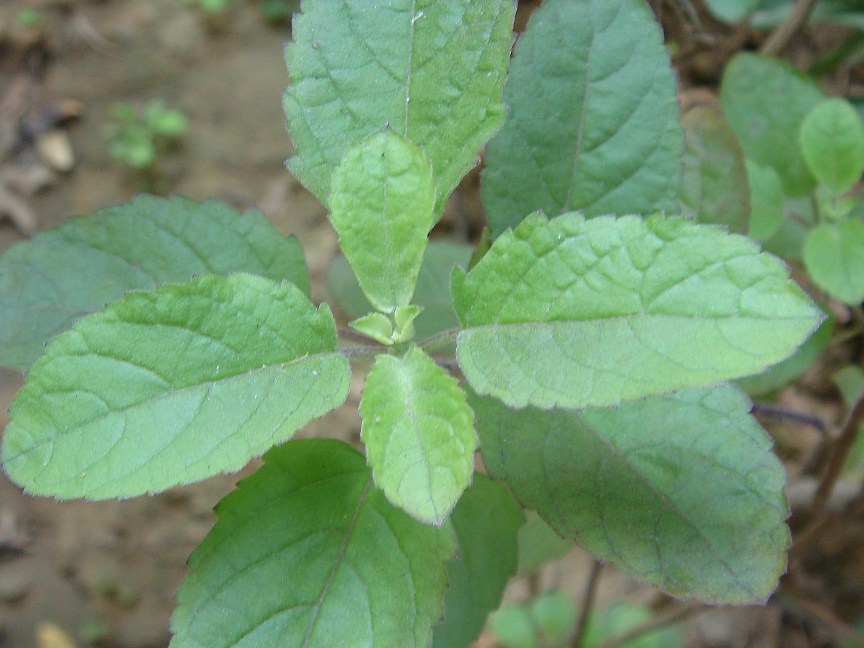  
Tulsi Neem Aloe
India not only has a wealth of medicinal plants, but the knowledge handed down through
generations, also has a host of do's and don’ts laid down for collecting the required portions - leaves, roots, fruit etc. of these plants. How an herb is grown and gathered affects its qualities. Thus plants collected for medicinal use should have no impurities
nearby and the location should be far away from a graveyard or cremation ground. Likewise, there should be no termite mounds in the vicinity. On no account should an insect infested plant be picked. And, significantly, plant material is to be gathered at its
freshest, that is, early in the morning.
Thus, studying ancient texts and examining traditional knowledge about medicinal plants, offers
scientists a virtually untapped reservoir of potentially useful sources of drugs, which can be used to provide affordable medicines to the world’s population in the new millennia.
|
Eco-travel
 
Ant hill in the premises
Young visitor at the river
Nature lovers’ haven in the outskirts of Mumbai
-S.Ananthanarayanan
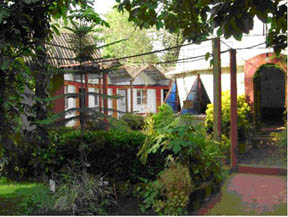
S.Ananthanarayanan introduces us to Prakash and Jyotsana, lovers of things natural and traditional and the piece of paradise on earth, which they have created at Murbad, near Mumbai
A short two hours drive from Mumbai takes one to Dattatreya Ashram, a 5 acre wonderland of simplicity and innovation, peace, communion
with nature and a chance to unwind with yoga and meditation.
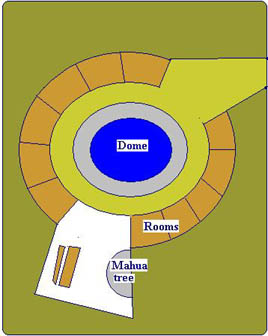
The centre-piece of the ashram is a low cost meditation hall, built as a Geodesic Dome. The dome is surrounded by a circle of simple
rooms, there is a kitchen, ample water and electricity. All around the ashram are selected plants and trees, each painstakingly transplanted from far and near and carefully tended to flourish for most of the time. . And then there is the river, with water
throughout the year, a 10 minute walk away, just along the border of the property.
The Ashram is the dream come true of Prakash Tendulkar, mountaineer, swimmer, yoga exponent, Sanskrit scholar, nature and medicinal
plant enthusiast and civil servant; and of his wife, Jyotsna, mountaineer, trecker, storehouse of Maharashtrian cuisine and folklore
and professor of Statistics in a leading Mumbai College.
Prakash had carried the dream of an ashram where one could experience peace, silence and solitude, practice yoga and be near nature,
yet be within easy reach from the city and also be built with the minimum cost, for many years. In the late 1990, with discussions with his many gifted friends and acquaintances, the dream began to take shape.
A plot of land, suitably away from the main highway, covered with greenery, in reach of a river and yet approachable within a few hours, came Prakash’s way.
Prakash had long dreamt of creating a facility making use of local materials. keeping the cost as low as possible and also making use of interesting devices and structures, the Geodesic Dome and a glass
pyramid being examples.
With the help of an architect from Kalyan, Mumbai, Prakash was able to finalise the design of the ashram - the Geodesic dome, surrounded
by 10 comfortable dwelling rooms, laid out in the form of a “lotus opening out”. The layout of the greenery, the nurseries, the positioning of pathways were also designed with care – the watchwords being simplicity and retaining the natural look.
At the entrance to the Ashram are a massive Mahua tree and 3 teak trees, originals of the plot before Prakash came there. Almost
no tree was cut in the layout of the Ashram, but ever so many were planted!
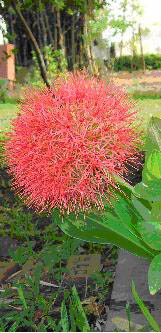
Over 150 types of medicinal plans thrive in the plant beds. A start had been made with 33 varieties that were already in the farm
– which were identified and labeled. Soon more were added, some being brought from Assam, from Kerala, Rajasthan or even the Himalayas.
There are varieties of trees, there is a solar cooker,
the farm has its own cows, with calf; and Nandi the bull, till Prakash gave it away to a farmer who had lost his own*. The farm also has Bambi the dog, ever ready to welcome visitors, and sundry birds, cobras, monitor lizards, rodents,
insects, wild boars, rabbits, nature’s bounty!
* CNN-IBN carried a report on 5th September of a gift of a bullock, by Prakash Tendulkar, a Railway employee in Mumbai, to a farmer in Buldhana, Maharashtra, who had lost one of his bullocks and was reduced to taking its place under the yoke.
The video clip is also on line, at www.ibnlive.com, under the link :
http://www.ibnlive.com/videos/20616/impact-bullock-farmer-gets-help.html
There is a pebble walk, paved with pebbles collected from different rivers in India and even from the banks of Manasarovar, in Tibet. “The idea is that a walk down the pebble
path can bring to the walker the benefit of visiting all the rivers and Manasarover too”, quips Prakash.
The interior of the meditation hall is a space where 30 persons can practice yoga, meditate or meet in harmony. There is also, within the hall, an artificial 'climbing wall'
– a facility to practice rock climbing. The wall is built with sand and cement, reinforced with iron mesh, and is provided with hand-holds made of ceramic, imported from France!
The inspiration for the climbing wall is Prakash and Jyotsana's old passion for mountaineering. Prakash is a veteran of 5 expeditions to Himalayan peaks with 3 successful ascents,
the highest being Mriguthani, at 22,500 ft, opposite Nanda Devi. Jyotsana is an avid trekker, with more than 10 trips, each over 100 km long, deep within the Himalayas.
Prakash, in his work as an officer in the Railways, has founded the Central Railway and Western Railway Adventure Sports Clubs, which sponsor several expeditions, recognised
by the Indian Mountaineering Federation, each year. Jyotsna, for her part, gets expeditions similarly recognised
and sponsored and leads youth and students, all over the Western Ghats or the Himalayas!
They live in Mumbai and spend most weekends at the Ashram, in Murbad, near Kalyan. They would love to have you over. Just drop them a line, at
pstendulkar@yahoo.com.
|
Zoo
Rhythm lightens the load
- S.Ananthanarayanan
Wildlife enthusiasts and trekkers, along with schoolchildren, have good news in a new, ergonomic way to carry loads, says S.Ananthanarayanan.
Prof Lawrence C Rome of the Univ of Penn, a biomechanics expert working with Marine Biological Laboratory, Mass, has provided elastic supports to the
load of the backpack, to even out the impacts of up-and-down movement. This is what, as many of us can affirm, wrecks havoc on the bones and muscles of shoulders and back, apart from the knees and ankles. The new design also reduces the energy needed to carry
the load and helps carry more or for longer.
Double whammy

In the traditional backpack, the load is rigidly fixed to the frame, which is then suspended on the shoulders and attacked to the waist. In normal walking,
the carrier rises and falls some 4 to 6 centimetres at each step. The load is then lifted by this distance and stopped in a fall through the same distance, at each step. The impact of the stop and lift is many times the load itself and soreness sets in within
minutes of setting out with anything but the lightest loads.
The other element is that for every pace of about 60 cms, there is a lift of 7 cms. So, if we walk 10 kms, we have lifted the load up more than a kilometer,
apart from moving the load forward. There is clearly something to be said for reducing how high the load needs to rise, and fall.
The Asian coolie
Like natural systems slip into the most efficient ways all by themselves, the traditional load carriers in our own part of the world had predated Prof
L C Rome of Pennsylvania.
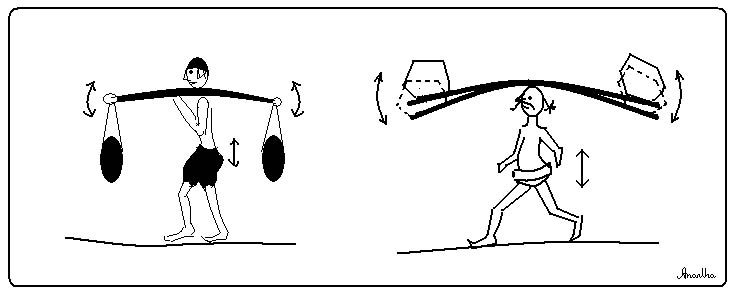
The porters and coolies and
bhishties of India and south-east Asia suspend loads from an elastic, shoulder-carried cantilever or an elastic frame balanced on the head.
When the carrier takes a step, the lift of the shoulder/head is transferred to the load with a little delay, because of the elasticity, some of the force
being taken up in bending the lever, rather than lifting the load. When the shoulder or head descends, again, the impact of the load descending is insulated. This apart, the impact is less because the load descends through a smaller distance.
Rhythm
But the best thing is that dimensions of the support are such that the natural frequency of the rocking of the support matches the up-down movement of
the carrier, so that when the carrier is at the lowest level and just rising, the load is at the highest level and ready to descend, thus reducing the effort needed. And when the carrier is highest, and the load is lowest, the carrier is descending and the
deeply bent support is helping, by getting straightened, in lifting the load.
The energy for the work done by the support is also supplied, of course, by the carrier, but keeping the right rhythm evens out the effort to be exerted
and reduces the impact of stopping and jerking up the load. A skilled worker can even adjust his speed and eliminate impact by keeping the load at the same level throughout!
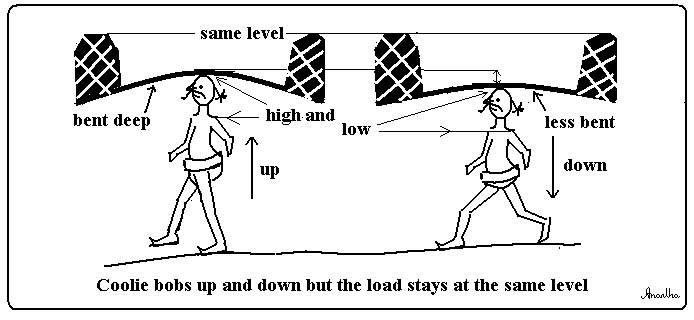
Ergonomic backpack

Prof L C Rome and MBL, Mass suspend the backpack load from the frame with elastic cords, the rope used for bungee jumping. When the hiker takes a step, then, the load does not rise with her, but stays put, while
the rubber stretches. It eases up as she reaches the highest point and keeps going, but never reaches as high as she did. And while descending, again, the load does not come to stop with a thud, but slower. And as the hiker has started rising, the load does
not go down as low as the hiker.
“While walking at 6.5 kmph, the vertical oscillation of a 27 kg load is reduced from 68.5 mm in the locked backpack to 26.5 mm in the suspended backpack”, says Prof. Rome in a communication published in
Nature in Dec 2006. “The metabolic cost of walking with the load falls from 640 W for the locked backpack to 600 W”, he adds.

This may not seem like a lot, at first, but it represents a 23% saving in the extra effort required for a grown man, who may weigh 70 kg, to walk with a 27 kg load as compared to without one. And this is apart from
the reduced orthopaedic and muscular trauma with the fixed load!
[the writer can be contacted at simple_science@indiatimes.com]
|